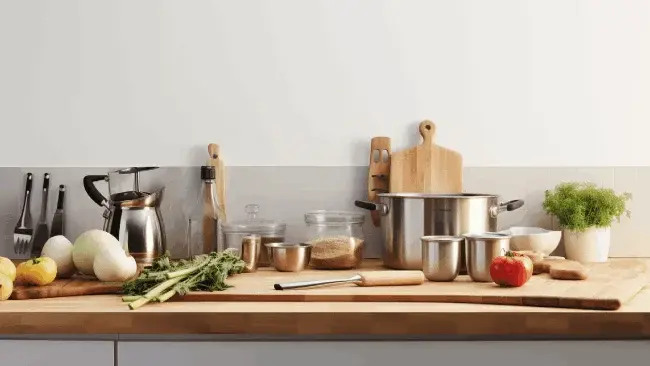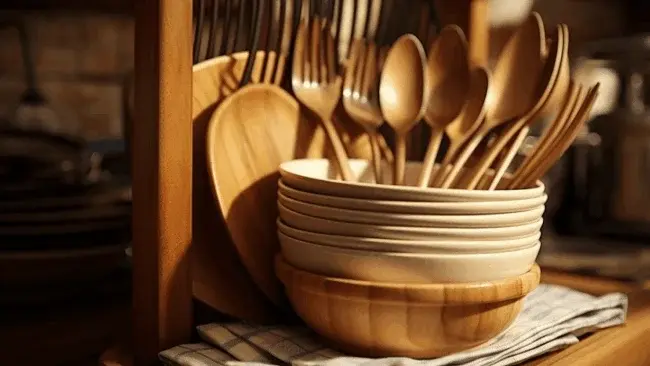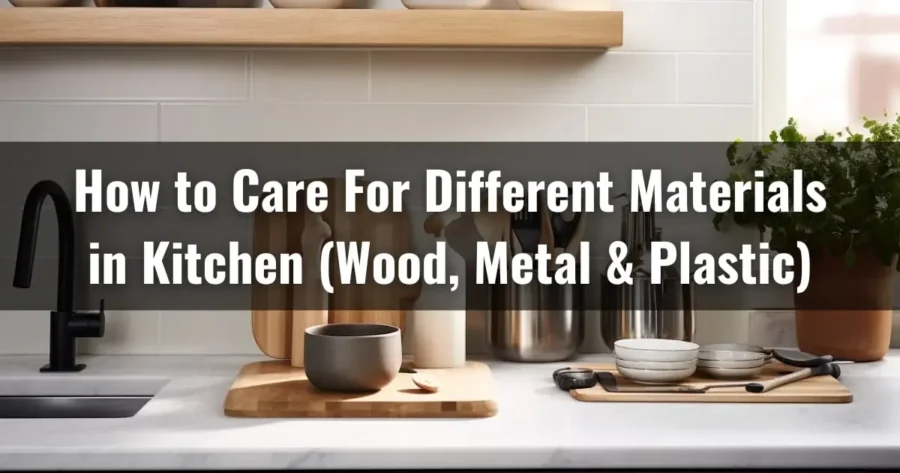The materials in your kitchen require special care and attention to maintain their quality and longevity. Wood, metal, and plastic utensils, dishes, and surfaces are common in any kitchen, but each material has specific needs and requirements to keep them in excellent condition.
In terms of wooden kitchen utensils, you need to hand wash them with warm, soapy water to prevent warping. For metal materials, prompt washing and drying can prevent stains and tarnishing. As for plastic materials, identifying reusable containers, effective cleaning strategies, and preventive measures are essential.
We’ll discuss in greater detail how to care for different materials in your kitchen to keep them in top condition.
Jump to Section
Caring For Different Kitchen Materials: Wood, Metal, Plastic Cleaning and Maintaining Techniques

The three most common materials found in the kitchen are wood, metal, and plastic, and we will discuss how to clean and maintain them in each of these categories:
1. Caring for Wooden Kitchen Materials
Your kitchen features an array of wooden essentials, from kitchenware to cabinets. Now, look at how to care for these wooden materials to ensure their longevity and natural beauty.
Cleaning and Maintaining Wooden Utensils and Kitchenwares:
As for maintaining the condition of your wooden utensils and kitchenware, our suggestion for you is to wash them by hand in warm, soapy water to get rid of food particles.
Use the scratchy side of a sponge to clean the wooden surfaces, ensuring that stubborn stains or residues are removed without damaging the wood. Avoid soaking your wooden utensils in water, as prolonged exposure can cause the wood to swell and lead to cracks and damage.
Regularly oil your wooden items to maintain their smoothness and prevent drying. We recommend that you use mineral oil regularly for maintenance. Beeswax is an excellent choice for a shiny surface, but be cautious as it may harden and melt at extreme temperatures.
To oil your wooden utensils, pour a small amount of oil on the surface and use a lint-free rag to spread it evenly. Then, allow it to soak, and then buff the surface with a clean rag to remove excess oil.
Cleaning and Maintaining Wooden Kitchen Cabinets and Worktops:
To care for wooden kitchen cabinets and worktops, immediately clean spills and stains to avoid any lasting marks. Perform weekly spot-cleaning using a multi-purpose cleaner or oil-based soap.
When cleaning finished wood cabinets and worktops, use soft brushes or cloths and wipe with the grain. For stains, use a mild detergent and water, avoiding harsh cleaning products.
If you have sticky wood cabinets, choose the appropriate cleaner based on the type of stain. Test new cleaners on a discreet wood part first and repeat the process if necessary.
It is possible to clean gritty kitchen cabinets using a variety of methods, including hot water and detergent, adhesive remover, all-purpose cleaner, or vinegar. Be patient and repeat the cleaning process if needed. Don’t forget to periodically deep clean the inside of your kitchen cabinets to prevent dust and grime buildup.
Empty the shelves, vacuum, wash with a mild detergent, and rinse and dry them properly before restocking. We strongly recommend that you refrain from using harsh chemicals and abrasive scrub pads as they can damage the wood finish.
Overlooks moisture control by avoiding prolonged exposure to moisture and ensuring proper drying to prevent dampness, which can reduce durability.
Care For Wooden Dining Tables in the Kitchen:
For protecting wooden dining tables in your kitchen, use placemats to prevent scratches caused by cutlery and plates. Avoid placing hot items directly on the table by using heat-resistant placemats.
Regular maintenance every 3-6 months is necessary for tables with a wax or oil finish. We recommend using natural wax and avoiding silicone-based wax, as it can negatively affect the wood.
When cleaning the table, mix white vinegar and warm water for disinfection, and use a soft, non-abrasive cloth to avoid damaging the finish.
You can remove scratches by lightly sanding the surface following the wood grain with fine sandpaper. Deeper scratches can be treated with vinegar and olive oil or a specialized wood filler.
For biro or ink stains, use rubbing alcohol or hand sanitizer, while water stains can be evaporated with a hairdryer or restored with mayonnaise overnight.
2. Caring for Metal Materials in the Kitchen
Various metal materials are found in your kitchen, from cookware to utensils to metallic surfaces. Discover how to keep these metal elements gleaming and functional at their best.

Caring for Metallic Kitchen Utensils and Kitchenware:
To properly care for metallic food prep utensils and kitchenware, one of the key things to keep in mind is prompt washing after use. Use hot water and a mild dish soap that is gentle on metals.
Avoid using abrasive materials that can scratch the metal surface, and instead, use a sponge or a soft brush for effective cleaning. After washing, it’s important to dry the metal utensils immediately with a clean kitchen towel to prevent water stains and preserve the quality of the metal.
Consider using a mixture of vinegar and baking soda for stubborn stains on stainless steel. Avoiding metal-to-metal contact while cleaning your metallic kitchen tools is important to prevent tarnishing.
Stainless steel, carbon steel, Damascus steel, and titanium each have unique properties that need to be maintained. In your kitchen, copper, brass, and bronze naturally oxidize, and you can polish them to retain their luster.
Tin requires gentle cleaning and naturally darkens with heat exposure. Silver and gold tarnish over time but can be polished to restore their shine.
Specialized Care For Metallic Kitchen Surfaces:
Maintaining metallic kitchen surfaces, like stainless steel countertops, requires specific steps. Wipe down the surface with a soft cloth or sponge to keep it looking pristine.
Avoid using metal scouring pads or abrasives, as they can cause scratches. Instead, opt for plastic scouring pads to protect the surface.
When choosing cleaners, our advice is to opt for non-chloride options like alkaline or chlorinated alkaline cleaners to effectively clean without damaging the metal. If your tap water is high in chloride, consider treating the water or installing decalcifiers to prevent potential damage.
3. Cleaning and Caring for Plastic Kitchen Materials
The best way to clean and care for your plastic kitchen materials is to use a gentle dish soap and warm water. After each use, promptly remove any leftover food and rinse the plastic container with warm water. Use a sponge or paper towel to wipe off any excess grease.
Wash the container in the sink with dish soap and warm water. Consider using a plastic booster or rinse aid in the dishwasher to enhance the cleaning process. You can expose stained containers to sunlight for a few hours. If odors persist, try using a baking soda and water scrub or undiluted vinegar.
To prevent future stains, consider spraying the inside of the container with unflavored cooking spray or lining it with foil or plastic wrap when not used for cooking.
FAQ’s: Care For Different Materials in Kitchen
Many homeowners have questions about the care and maintenance of their kitchen materials. Here, we address some of your most frequently asked questions to help you maintain your kitchen essentials’ longevity and quality.
Can I use the dishwasher to clean wooden kitchen utensils?
To ensure the integrity and longevity of your wooden kitchen utensils, we highly advise against using the dishwasher for cleaning. The dishwasher’s high heat and excess moisture can cause warping, cracking, and even breakage of your wooden spoons and utensils.

Instead, opt for handwashing them with soap and warm water. Gently scrub the utensils to remove any food residue, and then rinse them thoroughly.
After washing, allow them to air dry completely before storing them. This gentle cleaning approach helps maintain the natural beauty and functionality of your wooden kitchen utensils while avoiding the potential damage that can occur in the dishwasher.
How often should I oil my wooden kitchen utensils?
The frequency of oiling your wooden kitchen utensils depends on how often you use them. It’s generally recommended to oil your wooden cutting boards and spoons once a month for optimal maintenance and to prevent them from drying out.
However, the ideal oiling schedule can vary. Some people choose to oil their utensils once or twice a year, while others prefer a weekly basis.
To determine the most suitable interval for oiling, assess the usage and appearance of your utensils. By doing so, you can ensure that they remain in good condition and retain their smooth surface over time.
Can I use chlorine-iodine to clean stainless steel kitchen utensils?
Avoid using chlorine-iodine to clean your stainless steel kitchen utensils, as it can damage surfaces and cause corrosion or discoloration. Chlorine and iodine-based cleaning agents are too harsh for stainless steel and can lead to irreversible damage.
Instead, opt for non-abrasive cleaning products specifically designed for stainless steel. Look for gentle, pH-neutral cleaners that are safe for food contact surfaces.
Is it safe to use bleach to clean my kitchen plastic containers?
Using bleach to clean your kitchen plastic containers can be safe and effective, but you must exercise caution and follow proper dilution ratios and safety guidelines.
To ensure thorough cleaning and disinfection, create a mixture of unscented bleach and water. Use 55 ml of bleach for every 1 liter of water. Allow the container to soak in this solution for 30 minutes. This method helps eliminate potentially harmful particles like molds, making your container safer.
However, rinse the container thoroughly after the bleach soak to remove any residue. This ensures that the container is safe for storing food.
Conclusion
Caring for different materials like wood, metal, and plastic in your kitchen involves tailored techniques to maintain their longevity and functionality. For wooden utensils, handwashing with warm, soapy water is key, while metallic tools benefit from prompt cleaning and specific care for unique properties.
Plastic items thrive with gentle dish soap and warm water. The frequency of oiling wooden utensils depends on use, and always avoid using harsh chemicals on metallic surfaces.
Do not place wooden utensils in the dishwasher. Your kitchen essentials will shine with these practices, ensuring they serve you well and remain in top-notch condition for a long time.





